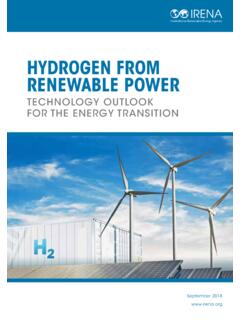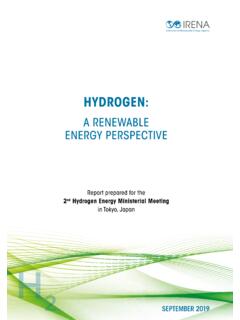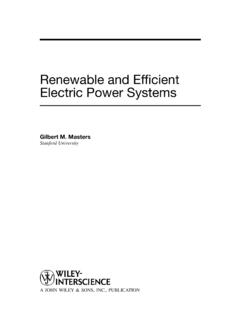Transcription of 2021 renewable energy industry outlook - Deloitte
1 2021 renewable energyindustry outlook renewable EnergyAccelerating energy industry convergenceIn 2020, states, cities, utilities, and businesses continued to announce or pursue decarbonization plans, despite the onset of a global pandemic and an economic recession. Even without a direct incentive for green infrastructure development in the economic stimulus measures passed in response to COVID-19, clean energy demand in the United States proved resilient as renewables and storage recorded declining costs and rising capacity and usage factors. What is more, renewables edged out other electricity generation sources when electric demand fell this year. As of early December, the share of renewables had exceeded that of coal in generation for 153 days compared with 39 days in According to the US energy Information Administration (EIA), electricity consumption will likely fall by year over year in 2020 and increase in renewable growth may accelerate in 2021 under a new administration focused on rejoining the Paris Climate Accord, investing heavily in clean energy , and fully decarbonizing the power sector by 2035.
2 For an industry that has focused heavily on solar and wind, supportive federal actions could help progress timelines for further expansion into new technologies, including advanced batteries and other forms of storage, offshore wind, and green hydrogen technology. As these new technologies, especially green hydrogen production and storage, move toward commercialization, we may see more power -to-x projects to store, convert, and reconvert surplus solar and wind power into carbon-neutral fuels and chemicals. The potential for increasing renewable energy demand, as well as the electrification of the transportation and industrial sectors and oil and gas companies plans to increase participation in the electricity value chain, are accelerating energy industry convergence.
3 These trends may foster collaboration that gives rise to new business models and helps advance the energy transition. Five enabling trends in the renewable energy industry could propel this energy convergence, as discussed below, along with five parallel trends in the broader power and utilities renewable energy industry outlook2021 renewable energy industry outlook3 Deal activity rises across the value chain as stakeholders consolidate positionsRenewable energy dealmaking will likely rise in 2021 as companies, utilities, and governments prepare to meet ambitious climate targets. Different types of industry players will likely consolidate their positions across the value chain. A growing number of special-purpose acquisition companies (SPACs) entering the clean energy space may also boost investment in renewables state renewable portfolio standards, increasing levels of corporate and residential demand, and improving economic competitiveness continue to be the key drivers for utilities and other energy companies interest in renewables.
4 Federal support, mandates, and stimulus could provide additional powerful drivers in 2021. The renewables segment continues to capture a significant share of deal activity in the power and utilities industry : 144 of the 174 merger and acquisition deals announced through early December involved renewable energy assets or , increasing challenges to gas pipeline projects may serve as an incentive for electric companies to bypass plans to invest in natural gas as a bridge fuel and double down on potentially less risky investments in renewables. In the most significant harbinger of this trend in 2020, Dominion energy and Duke energy canceled their joint Atlantic Coast Pipeline project due to high costs and legal challenges, and Dominion sold its gas transmission and storage business to focus on its state-regulated, sustainability-focused ,5 For investors, renewable energy assets may enhance their portfolios by generating steady cash flows and providing asset diversification.
5 Developers and installers may see opportunities for consolidation among distributed energy resource (DER) providers to lower costs, restructure projects to better handle delays, and gain efficiencies from complementary businesses. One such major consolidation deal, announced in July, was Sunrun s acquisition of Vivint solar, which will help consolidate the residential solar market, provide operational and financing cost benefits, and yield complementary business industry stakeholders may seize Consolidate: Competitive landscapeon additional opportunities to capitalize on DER growth. For example, Generac power Systems, a provider of backup generators, acquired Enbala power Networks, gaining access to its behind-the-meter, solar-plus-battery fleet and its virtual power plant and DER management platform to work as a power grid competitive landscape is also consolidating as FERC enables competition through renewable energy industry outlook4 Emerging hydrogen economy expands clean energy infrastructureAs decarbonization proceeds, many industry stakeholders are considering hydrogen production and storage projects, in addition to wind and solar, to find ways to cut carbon emissions.
6 power -to-gas involves producing green hydrogen through electrolysis using renewable -sourced electricity. This could reduce renewable energy curtailment, support renewable energy integration, provide long-duration seasonal electricity storage, and aid gas decarbonization. As a part of their decarbonization strategy, many electric and gas utilities announced pilots to ramp up renewable hydrogen production to be used in power generation, providing momentum to green hydrogen projects in the United In July, NextEra piloted a $65 million project to produce hydrogen from solar energy to replace a portion of the natural gas needed to fuel a power plant slated to come online by 2021, as renewable penetration on the grid increases, green hydrogen development is expected to follow because of its potential to act as seasonal storage of fuel available on demand to generate power for grid San Diego Gas & Electric Co.
7 Is planning to place two long-duration green hydrogen storage projects into service by 2022, the first such storage projects in the United hydrogen , like natural gas, lies at the intersection of electric and gas networks. Blending hydrogen with natural gas can support utilities decarbonization of gas distribution systems. National Grid, ConEdison, and Orange & Rockland Utilities have started researching the potential for hydrogen blending in their natural gas This would support other potential major opportunities for utilities to provide green hydrogen as a fuel for the transportation sector and as a feedstock for the industrial sector. In 2021, a new administration may help accelerate the timeline for green hydrogen to reach cost-competitiveness through its plans to invest in electrolyzer aggregation platforms can further help integrate renewables by integrating both stationary and vehicular battery : New economies22021 renewable energy industry outlook5 New battery business models emerge at both utility and residential scaleEnergy storage is becoming one of the fastest-growing asset classes in the energy industry .
8 Falling costs and maturing technology are making use cases for storage more economical, which could enable storage to provide multiple functions, from ancillary grid services to on-demand power . As noted in our 2020 renewable energy outlook ,13 utilities and their customers are expected to increasingly turn to microgrids, often including solar and storage, to build resilience, especially in the wake of recent extreme weather events and the cost synergies and operational efficiencies of pairing storage with solar offer significant value, boosted by the opportunity to reduce the capital costs of storage with the solar investment tax credit (ITC). Nearly 32% of the storage projects slated to come online in 2021 are The trend toward colocating supersized batteries is increasing as US solar-plus-storage prices fall.
9 The Gemini Solar project in Nevada is part of a trend of mega-solar projects coming online, with 380MW of storage Further, as new wind technologies continue to provide new repowering opportunities, adding batteries to wind projects may become more attractive to many Utilities are increasingly looking to energy storage to meet capacity shortfalls and have included it as a capacity resource in their integrated resource plans (IRPs) and issued requests for proposals for it. This could be bolstered by storage mandates in multiple states, including New York, New Jersey, and Arizona, which will likely ramp up storage deployments continue to grow despite the challenges of installing battery storage systems amid shelter-in-place orders, customer concerns about social distancing, and permitting and inspection challenges from COVID-19.
10 Moreover, resilience is emerging as a key driver going forward, especially in the wake of public-safety power shutoff events in California, even as some customers and developers continue to look at opportunities for storage to generate revenue via utility demand response programs and grid and wholesale market services. EV storage can further complement the role of utility and residential stationary battery : Battery business models32021 renewable energy industry outlook6 Wind is going offshoreThe wind industry s frontiers are expected to increasingly move offshore in 2021. After entering 2020 on a wave of supportive state and federal policy initiatives, the US offshore wind industry experienced a few hiccups with the delay of the first major utility-scale offshore wind However, the industry demonstrated resilience as construction of the first turbines ever installed in US federal waters was completed safely and on schedule despite the pandemic.


















